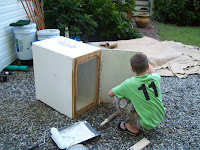Those damn trees get in the way. One of the problems with the conservation debate that you see so often is that people focus on one animal; this deer, that goose, instead of looking at species as a whole.
Most animal species in America are doing better now than they have in the last o

ne hundred years. Deer management has improved and in most places deer herds are busting at the seams. Turkeys have come back and extended seasons are taking place in many areas.
Elk herds are showing up in the mountains of North Carolina. Right here in Eastern North Carolina the
Red Wolves are staging a comeback of their own.
Wolves have been delisted in many states, and peregrine falcons have recovered. Bald eagles can be seen everywhere along the east coast (I saw one Sunday). The
United states has more wild lions than all of
Africa. (Thanks
Terrierman) Yes they are a completely different cat, but either way it is impressive.
All of these successes can be placed directly at the feet of good, scientific, wildlife management.
But folks don't want to hear it. They spend too much time anthropomorphizing the animals, pretending that they live in a Disney film. They don't want to accept that even wil

dlife needs checks and balances, and in the United States, one of the most successful balances we have is the American hunter.
I've said it before, I've never owned a gun used for hunting. I've never shot an animal with a bow or any other projectile, but I realize the importance of the hunter in the web of life that has become the American landscape.
What most animal rights people need to learn, is that decisions cannot be made based on pictures

of fuzzy little cubs, or chicks. Good decisions cannot be made by pretending that animals are people in fur suits that need lawyers to speak for them. Good decisions cannot be made by looking into the eyes of the squirrel you fed in your back yard and knowing he was destined for bigger and better things. Decisions need to be made based on what will most benefit a species as a whole.
Grey wolves in many states have made a tremendous comeback and the responsibility for their management has been given over to the states in which the wolves reside. A hunting season has been opened up on them to help control their numbers. The decision was based on sound scientific evidence so that the wolf numbers can be maintained and stay healthy.
People are screaming that this decision cannot happen. The evil hunters might shoot the cute little fuzzy creatures.
Besides hunters, there are no checks or balances on the wolf population except car impacts, starvation, and disease.
The
Nature Conservancy has a great article on the issue.
Many environmentalists are mad as hell that wolf management has been turned over to the states in Idaho (and soon Montana), leading to hunting seasons for these large, majestic predators.
As such, there is a very concerted effort to stop the wolf hunt – even after a federal judge ruled the hunt could tentatively continue.
This effort is certainly a great way to mobilize people into action.
But opposing the wolf hunt is not, ultimately, good for wolf conservation.
Stopping the wolf hunt essentially concerns saving individual wolves.
Conservation, by necessity, must concern a much broader view:
- How can we keep wolves a part of large, intact landscapes?
- How can we preserve the large forests necessary for wolves in the face of subdivision, climate change and energy development?
Such issues, unfortunately, don’t lend themselves to simple slogans or simple solutions.
Opposing the wolf hunt seems, on the other hand, to be a simple case of “crying wolf”: creating a conservation crisis where none really exists.
Gray wolves were reintroduced to parts of Montana, Wyoming and Idaho in 1995. By all accounts, they have thrived, much better than anyone expected. And so, as promised at the time of reintroduction, the states now have control over wolf management.
That means more wolf control and wolf hunting seasons: unacceptable to many environmentalists.

But sound science has never been an issue for many of the fringe environmentalists. I hate to generalize, but you can see the craziness of them in oh, so many of their rantings and ravings. Think about Peta, and ALF, and Elf, and now members of IDA spewing nonsense. I thank the Outdoor Chronicles for talking some sense.
So what to do? I don't always agree with decisions the government makes, and science (unbiased science) does change from time to time, but I think the best bet is to trust the science that manages our wildlife and the hunters that are initmately involved in true conservation. They are doing a pretty fair job.

And get involved with wildlife in a responsible and sustainable way, whether it be through hunting, or camping, fishing, or hiking.
Shoot, take up falconry if you want.









.jpg)




































